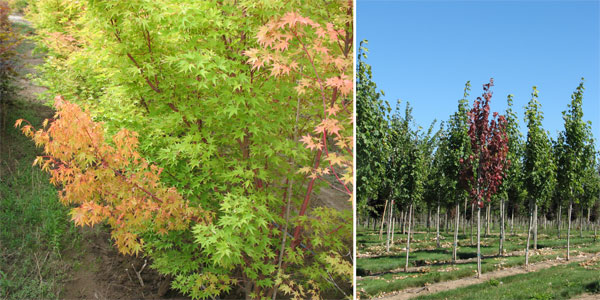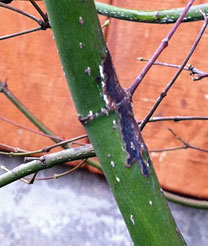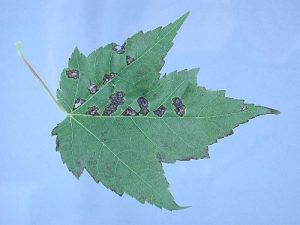 Download a pdf on Verticillium Wilt
Download a pdf on Verticillium Wilt
Diagnosis
A plant in your yard is dying. It is late summer, and, one limb at a time, the leaves shrivel and drop off. You cut a limb that has died from the poor tree and cut into it. You see black or brown streaking in the wood. This plant may be dying from a soil borne disease called Verticillium Wilt.
Many plants are susceptible to this disease. Unfortunately, if your soil is contaminated with it, there is no way to completely get rid of it. If you suspect that the soil in a planting bed is infected with verticillium wilt, clean and sterilize all tools used in that bed before using them in uninfected beds. If you have lost a plant and suspect Verticillium Wilt, the safest option is to replace the plant with one that is resistant to the disease.
The links below take you to specific disease information on this species. Verticillium in the Pacific Northwest.
| Acer sp. Maples Includes Japanese Maples, Vine Maples, Red Maples, Paperbark and others | Rheum sp. Rhubarb, both culinary and ornamental |
| Prunus sp. Cherries, Flowering Cherries, Laurel Hedges | Syringa sp. Lilac |
| Magnolia sp. Magnolia | Rhus sp. Sumac |
| Cercis sp. Redbud | Fuchsia sp. Fuchsia |
| Fraxinus sp. Ash Both our native Oregon Ash and ornamental Ash | Viburnum sp. Viburnum |
| Ulmus sp. Elm | Ribes sp. Currants and gooseberries, both edible and ornamental |
| Calluna sp. Heather | Rubus sp. Raspberry, Blackberry |
| Rosa sp. Rose | Fragaria sp. Strawberry |
| Vaccinium sp Blueberry, Huckleberry |
Plants Resistant to Verticillium Wilt:
| All conifers– Needled Evergreens, dwarf to giant estate trees | Fagus sp. Beeches |
| Ficus carica-Edible Fig | |
| Arctostaphylos– Manzanitas and kinnikinnik—Native broadleaf evergreen shrubs | Ginkgo biloba Maidenhair tree |
| Juglans sp. Walnuts, Butternut, Heartnut | |
| Betula sp. Birches | Malus sp. Fruiting & Flowering Apples |
| Buxus– Boxwoods | Pyracantha sp. Firethorn |
| Carpinus sp. Hornbeams | Pyrus sp. Fruiting & Flowering Pears |
| Ceanothus California Lilac Evergreen and deciduous shrubs | Grasses, Sedges |
| Daffodils, Lilies, Ferns | |
| Cercidiphyllum japonicum Katsura | Quercus sp. Oaks |
| Cornus sp. Dogwoods, both shrub and flowering | Salix sp. Willows |
Misdiagnosis!

Pseudomonas canker on maple bark
Two fairly common diseases that can look like Verticillium are Pseudomonas, or Bacterial Canker, and Anthracnose, a fungal disease caused by 2 or more fungi. It isn’t easy to tell these apart from Verticillium. A few clues: Pseudomonas often appears in the spring rather than late summer. If you look carefully at the dying limb, you may find a dark sunken area (a canker) low on the branch. The bark on the dying limb will peel off brownish and water soaked, but there will not be the dark streaking of Verticillium. Bacterial canker can infect many plants, including stone fruits and pears (both fruiting and ornamental), maples, lilacs, and others. The bacteria usually enters the plants through a wound, either weather caused, like frost damage, or an injury from something like pruning.
Bacterial Canker Prevention methods:
- Fall and spring sprays of fixed copper may help prevent Pseudomonas
- Another good practice is to avoid pruning susceptible plant during rainy spells- choose to prune when at least 48 hours of dry weather will allow pruning cuts to heal.
- Avoid planting susceptible plants in sites that are prone to spring frosts.

Anthracnose leaf spot on maple
Anthracnose is another spring disease usually appears first as spotting on the leaves or dieback on the tips of the leaf lobes, and only starts causing twig dieback when the disease becomes severe. It is usually most severe when spring is cool and rainy. Poor air circulation can make it worse. The various fungi that cause anthracnose can infect apples and pears, maples, dogwoods, and many other plants.
Both anthracnose and bacterial canker are airborne diseases. If you have lost a plant to one of these, the soil is not affected, and you can replant. If you are unsure is your plant succumbed to a canker disease or verticillium, it is safest to replace the plant with a verticillium resistant variety. If pruning any plant that shows symptoms of any disease, always sanitize your tools between cuts, and especially between plants. Tools can be sanitized by alcohol dips, torching with a small propane torch, or Lysol spray.
